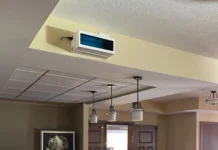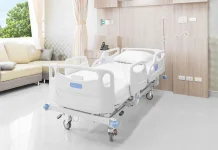By Troy Cowan, facilitator, troyc@visionbasedconsulting.us
IUVA Healthcare/UV Working Group
As we continue to make the case for wider application of germicidal UV (GUV) to reduce the risk of potentially infectious pathogen exposures, we keep asking two questions: What are we waiting for?, and What needs to be done? This is an attempt to answer those questions and provide future direction.
Q1: What’s the problem? COVID-19 and Its Variants
After two and a half years, the US has recorded almost 101.9 million cases of COVID-19, with 46 of our 50 states having counties with high and/or medium-level infection rates. 1
Laboratory, field and case studies have demonstrated that airborne transmission via inhalation of virus-laden aerosols is important, if not dominant, for COVID-19. 2
COVID-19 is mutating very rapidly. The predominate strain of COVID-19, XBB.1.5, first appeared in November 2022 and, in just three months, has become ~49.1% of all new cases. 3
Q2: What’s the Big Deal? The Nuisance Factor Could Prove Fatal.
Dr. E. Nardell, Harvard, has said, “The good news is that this pandemic will eventually end due to effective vaccines, infection-induced herd immunity and the further evolution of the virus. The bad news is that, like seasonal influenza, COVID-variants may be with us for years to come, and this will certainly not be the last respiratory virus pandemic.” 4
Yet, it is highly concerning to the medical community that “novel Omicron subvariants are emerging at an extraordinary rate, despite vaccination and prior infection-induced immunity in the majority of the global population.” 5
Even a negative PCR test doesn’t guarantee a person is recovered. A recent article in The Journal of Pathology said, “A few patients with COVID-19 appear to recover from an acute viral infection but nevertheless progress in their disease and eventually die,” despite persistent negative SARS-CoV-2 tests. 6
The growing indifference to this nuisance by the general population could be as fatal as the disease.
Q3: What’s Your Idea? Upper-Room GUV Air Treatment
Healthcare practitioners now are recognizing how “…indoor environmental parameters related to mechanical ventilation systems of a hospital building are impacting patients.” 7
Science is promoting the idea that managing “…the indoor microbiome can help prevent the spread of disease and contribute to human longevity, health and well-being.” 8
In March 2022, the Biden-Harris Administration’s Clean Air in Buildings Challenge asked all building owners and operators across the domains of school, work and travel to “…improve indoor air quality in their buildings and reduce the spread of COVID-19.” 9
As mentioned in Lancet’s COVID-19 Commission report, “…to reduce the risk of airborne infectious disease transmission that every building should implement other technologies [i.e., in addition to ventilation measures] such as germicidal ultraviolet (GUV) lights… 10
Over the last two and a half years, “scientists and government officials around the world have promoted a string of preventive measures – handwashing, vaccination, social distancing, mask-wearing, ventilation. None of them is perfect; they are often described as ‘layers in a Swiss cheese model’ of risk reduction.” 11 In other words, the more steps taken, the safer the population will be against COVID-19. 12 GUV can be one of those steps.
Q4: Does GUV Work? Yes.
Upper-room GUV has been used successfully “since the 1940s in high-risk settings, e.g., TB wards in hospitals, homeless shelters, microbiology labs and in schools to prevent the spread of measles.” 13
Since the onset of COVID-19’s pandemic, upper-room GUV has seen “…wider applications in office buildings, schools, nursing and long-term care facilities, places of worship, museums, airports, restaurants, spas and numerous other environments where people congregate.” 14
When designed correctly, an upper-room GUV system “consisting of lamps hung in the upper part of a room, or an in-duct system with lamps that radiate the air as it moves past the light, is very effective at inactivating airborne viruses and bacteria.” 15 This includes SARS-CoV-2, influenza virus, tubercle bacilli and measles virus. 16
An upper-room system “augments ventilation by producing equivalent air disinfection as if increased normal ventilation air changes” and is recommended by “WHO (2019), CDC (NIOSH 2009) and IES (IES: RP 24 2021 RP 27.1 2022).” 17
Q5: Is Upper-Room GUV Safe? When Used Properly, YES!
According to the FDA, we should “avoid direct skin exposure to UVC radiation and never look directly into a UVC light source, even briefly.” Even so, “…skin burns and eye injuries from UVC exposure usually resolve within a week with no known long-term damage. Since the penetration depth of UVC radiation is very low, the risk of skin cancer, cataracts or permanent vision loss is also thought to be very low.” 18
While there have been incidents of accidental overexposure from poorly installed upper-room systems, 19 proper installations of well-engineered GUV systems readily meet exposure limits set by ACGIH. 20 Dr. Nardell has noted in a WHO webinar that “UV germicidal irradiation can be safely and effectively used for upper-air disinfection without a significant risk for long-term delayed effects, such as skin cancer.” 21
Additional guidance on the safe installation and use of GUV systems can be found in IES publications “IES-RP-44 Recommended Practice: Ultraviolet Germicidal Irradiation” 22 and “IES RP-27 Recommended Practice: Photobiological Safety for Lighting Systems.” 23
Q6: What About Other Options for Infectious Disease Control in Public Spaces?
According to ASHRAE, in an October 2022 position paper, the primary options include “…dilution with outdoor air provided by mechanical or natural ventilation, filtration of indoor air, indoor airflow patterns and disinfection by germicidal ultraviolet light and other technologies proven to be effective and safe.” 24 [italics added for emphasis]
ASHRAE earlier affirmed that while “Ventilation represents a primary infectious disease control strategy through dilution of room air around a source and removal of infectious agents (CDC 2005),” 25 “…it remains unclear by how much infectious particle loads must be reduced to achieve a measurable reduction in disease transmissions and whether the efficiencies warrant the cost of using these controls.” 26
There are hidden dangers on the use of other disinfection methods: “…biocides (i.e., disinfectants, antiseptics and preservatives) commonly used in hospital settings and elsewhere…have been implicated in the emergence of antibiotic resistance in bacteria.” 27 Further, these chemicals, especially when used to treat public spaces (e.g., “quats”), also may leave hazardous residues and pose a toxic exposure risk. 28
Q7: What is Being Done to Help Implement GUV?
Industry associations are designing and promoting industry-consensus standards for GUV upper-room systems nationwide. For example:
ASHRAE’s GPC 37 guidelines are being updated “… to provide minimum requirements for safe and effective implementation of upper room…systems for air disinfection. The guidelines describe best practices for assessing…what is necessary for commissioning, design, installation and maintenance and operation.” 29
The National Association of Lighting Management Companies (NALMCO) is offering hands-on training for GUV installers with fixtures and testing equipment at its Spring Seminar. 30
Q8: How Do We Know We Got the Right Ones?
Recently issued standards (e.g., ANSI/IES/IUVA-92-22) specify how to accurately and reliably measure the irradiance output of various GUV sources, available through ANSI. 31
ASHRAE is producing new standards for measuring GUV efficacy in HVAC and upper-room systems (i.e., ASHRAE’s 185.3) and on surfaces (i.e., ASHRAE’s 185.4). 32
NEMA and IUVA are working together on a new “labeling” standard for voluntary labeling and reporting of key product information for various UVC devices and key components (e.g., intended uses, and performance, measured using applicable industry standards).” 33
Q9: How Do We Make Sure It’s Done Right?
We would suggest that public health officials, facility managers and operators, and all concerned stakeholders assure themselves that GUV upper-room systems – whether installed, in the procurement process or in planning – are in compliance with the above guidance, to the extent practicable, as recommended by WHO, CDC and IES. 34 Easily said but challenging to implement.
Q10: What Are the Next Steps?
Getting our Federal health officials and regulators to acknowledge and adopt the industry-consensus standards on GUV in accordance with OMB Circular A-110, Section 5, which states, “…all Federal agencies must use voluntary consensus standards in lieu of government-unique standards in their procurement and regulatory activities, except where inconsistent with law or otherwise impractical.” 35
Asking our public health officials and the facility managers and operators of public facilities to implement and operate GUV air treatment systems as a standard practice, wherever practical, in accordance with the WHO, CDC and IEC recommendations 36 and using industry-consensus standards, mentioned above.
Engaging our research institutions in developing models and studying the impacts of GUV on public health using quantitative microbial risk assessment techniques 37 to assist in formulating better responses to future pandemics.
Engaging concerned GUV stakeholders in building consensus in what plans need to be developed and directions to be taken in the next round of GUV initiatives, to be addressed in a workshop now in planning for June 2023.
Q11: So, What Are We Waiting For?
In the October 2022 White House Summit for Indoor Air Quality, Prof. S. Miller, University of Colorado-Boulder, shared: “When we started to regulate and protect the environment in the 1970s, we focused on water quality and outdoor air quality because we saw those as public goods. But we never saw the indoor environment as a public good as well.” She added, “We need a paradigm shift for thinking about indoor air quality.” 38
In his TIME magazine article, Dr. Nardell stated, “Upper-room germicidal UV (GUV) fixtures are a more than 80-year-old technology, well-proven, safe and unused technology for airborne infection control… All known pathogenic microbes…are susceptible to GUV.” 39 The article continued, “Compared to mechanical ventilation and room-air cleaners, GUV is cheaper and much more effective.” 40
We agree with Prof. Miller and Dr. Nardell. We need that paradigm shift in how we manage indoor air quality, and we need to shift it toward GUV air treatment. It works, it’s cheaper, it’s more effective and it’s for the public good.
It’s all about saving lives.
The IUVA Healthcare/UV Working Group endeavors to promote the acceptance of UV disinfecting technologies as a credible, valued part of environmental management throughout the healthcare industry. In this column, the UV community will be updated on these efforts and the latest information on UV technology as it pertains to the healthcare industry.
References
- CDC, COVID Data Tracker Weekly Review, 20 January 2023, https://www.cdc.gov/coronavirus/2019-ncov/covid-data/covidview/index.html, last accessed 22 January 2023
- Task Force on Safe Work, Safe School, and Safe Travel, “The First Four Healthy Building Strategies Every Building Should Pursue to Reduce Risk from COVID-19,” Lancet COVID-19 Commission, July 2022, https://covid19commission.org/commpub/the-first-four-healthy-building-strategies-every-building-should-pursue-to-reduce-risk-from-covid-19, last accessed 24 Jan 2023
- CDC, COVID Data Tracker Weekly Review, as cited above, last accessed 22 January 2023
- E. Nardell, “If We’re Going to Live With COVID-19, It’s Time to Clean Our Indoor Air Properly,” Time Magazine, 1 February 2022, https://time.com/6143799/covid-19-indoor-air-cleaning/, last accessed 25 January 2023
- N. Mathur, “The “Great Escape” by SARS-CoV-2 XBB.1,” News Medical, 17 Jan 2023, https://www.news-medical.net/news/20230117/The-Great-Escape-by-SARS-CoV-2-XBB1.aspx, last accessed 28 Jan. 2023
- R. Bussani, et al., “Persistent SARS-CoV-2 infection in patients seemingly recovered from COVID-19,” Journal of Pathology, 18 January 2023, https://doi.org/10.1002/path.6035, last accessed 25 Jan 2023
- A. Shajahan, C. Culp, B. Williamson, Abstract of “Effects of Indoor Environmental Parameters related to Building HVAC Systems on Patients’ Medical Outcomes: A Review of Scientific Research on Hospital Buildings,” Indoor Air, Manuscript ID INA-18-08-174.R2, 10 Dec 2018
- National Academy of Sciences (NAS), “Committee on Microbiomes of the Built Environment: From Research To Application,” 2017, ISBN 978-0-309-44980-9 | DOI 10.17226/23647, Preface, https://nap.nationalacademies.org/catalog/23647/microbiomes-of-the-built-environment-a-research-agenda-for-indoor, last accessed 22 Jan 2023
- The White House, “Clean Air in Buildings,” https://www.whitehouse.gov/cleanindoorair/ . Published March 17, 2022. last accessed 22 Jan 2023.
- The Lancet COVID-19 Commission, “The First Four Healthy Building Strategies Every Building Should Pursue to Reduce Risk from COVID-19,” July 2022, “Other Considerations, pg. 6, https://covid19commission.org/commpub/the-first-four-healthy-building-strategies-every-building-should-pursue-to-reduce-risk-from-covid-19, last accessed 22 Jan 2023
- C. Baraniuk, “How to fight Covid with light,” Knowable Magazine, 29 Sept. 2022, https://knowablemagazine.org/article/health-disease/2022/how-fight-covid-with-light, last accessed 22 Jan 2023
- University of Iowa (UI), “Why Swiss cheese model may be the key to keeping you safe from COVID-19,” “The Loop” UI Healthcare Newsletter, 5 Aug 2021, https://medcom.uiowa.edu/theloop/news/why-swiss-cheese-may-be-the-key-to-keeping-you-safe-from-covid-19, last accessed 28 Jan 2023
- R. Vincent, et al., “GPC 37: Guidelines for the Application of Upper-Room Germicidal Ultraviolet (UV-C) Devices to Control Transmission of Airborne Pathogens: A Preview,” UV Solutions, 2022 Quarter 4, pg 32, https://uvsolutionsmag.com/articles/2022/gpc-37-guidelines-for-the-application-of-upper-room-germicidal-ultraviolet-uv-c-devices-to-control-transmission-of-airborne-pathogens-a-preview/ , last accessed 25 January 2023
- Ibid.
- The Lancet COVID-19 Commission, “The First Four Healthy Building Strategies Every Building Should Pursue to Reduce Risk from COVID-19,” as cited above, last accessed 22 Jan 2023
- R. Vincent, et al., cited above, last accessed 25 January 2023
- Ibid.
- FDA, “Ultraviolet (UV) Radiation,” FDA website, (https://www.fda.gov/radiation-emitting-products/tanning/ultraviolet-uv-radiation), last updated 19 Aug 2020, last accessed 25 Jan 2023
- C. Shields, “Students, faculty complain of health problems due to UV lights on campus,” The Lamron student newspaper, 11 March 2022, https://www.thelamron.com/news/ulz68clbggc309i4esl3hmi2r1zo2i, last accessed 28 Jan 2023
- E. Nardell, “SARS-CoV-2: Dynamics of Airborne Transmission and Air Disinfection,” presentation in WHO webinar, slide 27, presented on 17 Dec. 2021
- Ibid.
- IES, “IES RP-44 Recommended Practice: Ultraviolet Germicidal Irradiation (UVGI),” IES Standards Library, https://standards.globalspec.com/std/14397432/rp-44, last accessed 30 Jan 2023
- IES, “IES RP-27 Recommended Practice: Photobiological Safety For Lighting Systems,” IES Standards Library, https://standards.globalspec.com/std/14361315/ies-rp-27, last accessed 30 Jan 2023
- ASHRAE, “ASHRAE Positions on Infectious Aerosols,” approved by the ASHRAE Board of Directors October 13, 2022, expires October 13, 2025, pg.’s 1-2, https://www.ashrae.org/File%20Library/About/Position%20Documents/PD_-Infectious-Aerosols-2022_edited-January-2023.pdf, last accessed 28 Jan 2023.
- ASHRAE, “ASHRAE Position Document on Airborne Infectious Diseases,”, originally published 19 Jan 2014, reaffirmed 5 Feb 2020, expired 5 Aug. 2020, http://www.kentherm.com.br/media/airborne-infectious-diseases.pdf, las accessed 28 Jan 2023
- Ibid.
- J. Maillard, “Biocide Use and Antibiotic Resistance,” Introduction (pg. 465) to Chapter 25, Antibiotic Policies: Theory and Practice. Edited by Gould and van der Meer Kluwer Academic / Plenum Publishers, New York, 2005, https://www.researchgate.net/profile/Andreas-Voss-5/publication/225316153_Disinfection_Policies_in_Hospitals_and_the_Community/links/0deec51828887eda92000000/Disinfection-Policies-in-Hospitals-and-the-Community.pdf, last accessed 24 Jan 2023
- X. Lim, “Do we know enough about the safety of quat disinfectants?” Chemical & Engineering News, Volume 98, Issue 30, ISSN 0009-2347, https://cen.acs.org/safety/consumer-safety/know-enough-safety-quat-disinfectants/98/i30, last accessed 28 Jan 2023
- R. Vincent, et al., cited above, last accessed 25 January 2023
- NALMCO, “GUV Hands-on Training , NALMCO Spring Seminar 2023,” 7 March 2023 @ 8:30am, Indianapolis IN, https://na.eventscloud.com/website/49471/agenda/, last accessed 29 Jan 2023.
- IES & IUVA, “Approved Method: Optical And Electrical Measurement Of Ultraviolet LEDs,” ANSI/IES/IUVA LM-92-22, ISBN-13: 978-0-87995-419-2, 2022, available at https://webstore.ansi.org/standards/iesna/ansiiesiuvalm9222, last checked 29 Jan 2023.
- T. Cowan, “Thanks for Getting Out the Good News about UV-C,” UV Solutions, 2021 Quarter 4, 9 Dec 2021, https://uvsolutionsmag.com/articles/2021/thanks-for-getting-out-the-good-news-about-uv-c/, last accessed 29 Jan 2021
- T. Cowan, “Focus on Healthcare/UV Disinfection: Science Says UV Fights COVID-19 and Helps Save Lives. Why Are We Waiting?,” UV Solutions, 2022 Qtr 1, 17 Mar 2022, https://uvsolutionsmag.com/articles/2022/focus-on-healthcare-uv-disinfection-science-says-uv-fights-covid-19-and-helps-save-lives-why-are-we-waiting/, last accessed 29 Jan 2023
- R. Vincent, et al., cited above, last accessed 25 January 2023
- Executive Office of the President, “OMB Circular A-119: Federal Participation in the Development and Use of Voluntary Consensus Standards and in Conformity Assessment Activities,” Section 5, pg. 17, issued 22 Jan 2016, https://www.nist.gov/system/files/revised_circular_a-119_as_of_01-22-2016.pdf, last accessed 30 Jan 2023
- R. Vincent, et al., cited above , last accessed 25 January 2023
- Minnesota Dept. of Health, “Quantitative Microbial Risk Assessment Basics,” Website, https://www.health.state.mn.us/communities/environment/risk/guidance/dwec/basics.html, updated 3 Oct 2022, last accessed 30 Jan 2023
- Michael Lock Swingen, “Professor Shelly Miller joins White House summit on indoor air quality,” University of Colorado Boulder/College of Engineering and Applied Science/Paul M. Rand Mechanical Engineering Dept. Website article, 1 Nov 2022 (https://www.colorado.edu/mechanical/2022/11/01/professor-shelly-miller-joins-white-house-summit-indoor-air-quality), last accessed 14 Nov 2022
- E. Nardell, “If We’re Going to Live With COVID-19, It’s Time to Clean Our Indoor Air Properly,” cited above, last accessed 30 Jan 2023
- Ibid.






